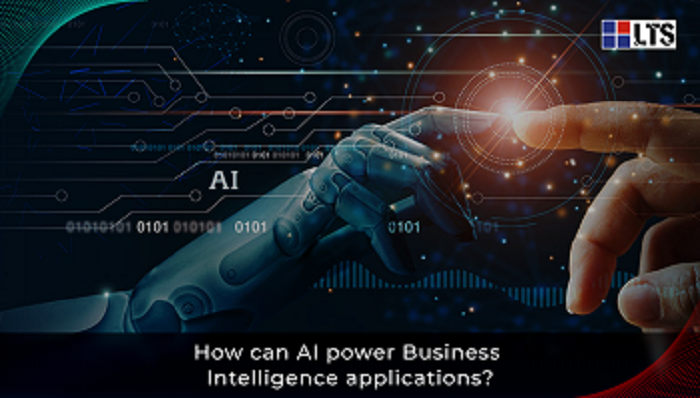- July 15, 2022
Leo Administrator
- in business intelligence and analytics
- 0Comments
How can AI power Business Intelligence applications?
Artificial Intelligence is already here. How is it impacting business every day?
Artificial intelligence has many business areas, such as streamlining workflows and aggregating business data. Artificial intelligence (AI) is expected to take technology out of the two-dimensional screen and incorporate it into the three-dimensional physical environment surrounding people. This blog is aimed at business owners, and employees who want to understand how using artificial intelligence is changing the way they do business.

Artificial Intelligence (AI) enables businesses to pull out valuable insights that will allow enterprises to forecast industry trends and user behaviour. Companies are eager to hire AI developers and Business Intelligence and Analytics to upgrade solutions. More or less, AI usage in business intelligence and analytics can bestow enterprises with billions of dollars worth of information. Artificial intelligence (AI) and the ability to uncover valuable insights enable businesses to predict industry trends and user behaviour. For this reason, companies are keen to employ AI developers and business intelligence and analytics to upgrade their solutions. Using more or less AI in business intelligence and analytics can provide businesses with billions of dollars worth of information.
Are you interested in how to use AI in business intelligence? Let’s understand the undeniable potential of AI in business intelligence and analytics?
You Can gauge Business intelligence (BI) potential by breaking down a large volume of data into granular insight. It enables businesses to understand the more minor aspects of the big picture, and AI increases the capacity and functionality of BI.
BusinessIntelligence’s mainstream process is to process and visualize data. BI cannot generate these data results and predict trends in real-time.
Are you wondering how we Can Use AI in business intelligence?
Understand the undeniable potential of AI in business intelligence and analytics.
You Can understand the potential of business intelligence (BI) by breaking down large amounts of data into detailed insights. This allows companies to understand more minor aspects of the big picture. Artificial Intelligence (AI) also improves the capacity and functionality of BI applications. The mainstream business intelligence process is to process and visualize data, and BI cannot generate these results or predict trends in real-time.
AI vs BI – Differences and Synergies.
Business intelligence, analytics, and artificial intelligence are increasingly crucial yet often misunderstood BI tools in an enterprise context. Artificial intelligence (AI) uses computer systems to simulate multiple attributes of human intelligence.
Are Artificial Intelligence and Machine Learning the End of Business intelligence?
On the contrary, AI and ML add much to the field of business intelligence and analytics.
The required report size increases each time a new variable is added to a business transaction. The effect is higher if these variables are in the early stages of a transaction. (From another perspective, it adds a layer of reporting to every business decision.)
For example, in the retail industry, ML initiates a series of events leading up to the actual transaction. Will be, and the user decides to continue the transaction. Or even before the company decides to approach the user for that transaction. Each of these decision-making steps needs to be analyzed and further analyzed to ensure support for business growth.
One of the main reasons BI has been driven has always been to integrate as many business decisions as possible into automated processes. When making decisions, we’re not too far away (compared to what’s feasible). AI helps with this. Improvements in ML will increase the relevance of BI to the scope of BI and BI in daily life. (In fact, it’s no exaggeration to say that ML is in business intelligence.)
When we hear about future headcount reductions that people mention when talking about AI and automation, that means only one. Classic work is excluded. Inevitably, You will create many new opportunities. Power Bi and power BI for developers are increasingly growing due to their high demand. Present your business data in context with stunning interactive data visualization in applications, websites, portals, SharePoint, and Microsoft Teams. With the Power BI REST API and client API, you can easily embed interactive reports and dashboards for a consistent, realistic experience across devices. Explore client APIs in the Power BI Embedded Analytics Playground and browse interactive showcases to learn how to improve Power BI Analytics for your business and customers.
How is Artificial Intelligence Assisting Business Analytics?
Artificial intelligence or AI is used to train computer systems with human intelligence characteristics such as learning, problem-solving, and decision-making. Enterprise AI applications are made possible primarily by AI-powered machine learning (ML) technology that can use to perform specific tasks such as:
Reading and understanding written text such as user feedback and suggestions.
Known and classify visual images and photos.
Recognizes facial features and objects, enabling face recognition and product recommendations.
Mobile App Vulnerability Testing Strategy –
The mobile network enables users to run almost any business, finance, social operation, etc.; every company has launched its own mobile application. These apps are very efficient and make everyday transactions easy. However, there are significant concerns about data security and security. Vulnerability testing of mobile apps is critical to maintaining security and other operations.
Vulnerability assessment and penetration testing is the process of protecting a computer system from attackers by evaluating the computer system for loopholes and vulnerabilities.
For more details on Business Intelligence, click here: https://en.wikipedia.org/wiki/Business_intelligence.
[/vc_column_text][/vc_column][/vc_row]
How is artificial intelligence assisting business analytics?
By definition, artificial intelligence or AI is the term used to train computer systems with human intelligence characteristics such as learning, problem-solving, and decision making. Enterprise AI applications are made possible primarily by AI-powered machine learning (ML) technology. It can be used to perform specific tasks such as:
Reading and understanding written text such as user feedback and suggestions.
Recognize and classify visual images and photos.
Recognizes facial features and objects, enabling face recognition and product recommendations.
On the contrary, AI and ML add much to the field of business intelligence and analytics.
The required report size increases each time a new variable is added to a business transaction. The effect is higher if these variables are in the early stages of a transaction. (From another perspective, it adds a layer of reporting to every decision a business makes.)
For example, in the retail industry, ML initiates a series of events leading up to the actual transaction. Will be. The user decides to continue the transaction. Or even before the company decides to approach the user for that transaction. Each of these decision-making steps needs to be analyzed and further analyzed to ensure support for business growth.
In fact, one of the main reasons BI has been driven has always been to integrate as many business decisions as possible into automated processes. When it comes to making decisions, we’re not too far away (compared to what’s feasible). AI helps with this. Improvements in ML will increase the relevance of BI to the scope of BI and BI in daily life. (In fact, it’s no exaggeration to say that ML is in the realm of business intelligence.)
When we hear about future headcount reductions that people mention when talking about AI and automation that means only one. Classic work is excluded. Inevitably, many new opportunities will be created. Power Bi and powerBI for developers are increasingly growing due to their high demand. Present your business data in context with stunning interactive data visualization in applications, websites, portals, SharePoint, and Microsoft Teams. With the Power BI REST API and client API, you can easily embed interactive reports and dashboards for a consistent, realistic experience across devices. Explore client APIs in the Power BI Embedded Analytics Playground and browse interactive showcases to learn how to improve Power BI Analytics for your business and customers.
